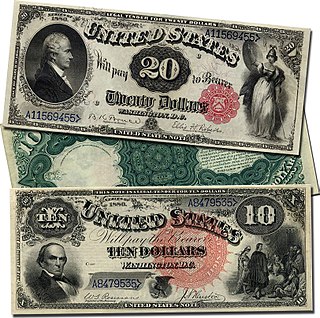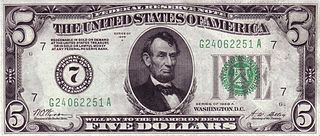Since 1928
Series 1928 was the first series of modern, small-sized notes issued. Since then, the series year has been changed when there is a major design change to a bill; a minor design change is indicated by a letter suffix being added to the series year. Major design changes were rare until 1974 when William E. Simon became Secretary of the Treasury. Before 1974, a change to either the signature of the Secretary of the Treasury or the Treasurer was considered a minor change; after 1974, a new Secretary of the Treasury was considered a major change. (The only exception to this was in 1979, G. William Miller's signature appeared on Series 1977A instead of Series 1979.) A change in Treasurer is still considered a minor change. The 2017A series was due to a minor change in production, possibly of the ink used. [1] Changes in design, such as the recent changes to the $20 bill to deter counterfeiting, are still considered major changes.
Tate-Mellon: 1928 $1 Silver Certificate, 1928 $2 United States Note, 1928 $5, $10, and $20 Federal Reserve Notes.
Woods-Mellon: 1928 $10 Gold Certificate, 1928A $1 Silver Certificate, 1928A $2 United States Note, 1928 $5 United States Note, 1928A $5, $10, and $20 Federal Reserve Notes, 1928B $5, $10, and $20 Federal Reserve Notes, 1928 $50 and $100 Federal Reserve Notes, 1928A $50 and $100 Federal Reserve Notes.
Woods-Mills: 1928B $1 Silver Certificate, 1928B $2 United States Note, 1928A $5 United States Note, 1928C $5, $10, and $20 Federal Reserve Notes.
Woods-Woodin: 1928C $1 Silver Certificate, 1928 $1 United States Note, 1928D $5 Federal Reserve Note.
Julian-Woodin: 1928D $1 Silver Certificate, 1933 $10 Silver Certificate.
Julian-Morgenthau: 1928E $1 Silver Certificate, 1934 $1 Silver Certificate, 1935 $1 Silver Certificate, 1935A $1 Silver Certificate, 1934 $5 Silver Certificate, 1934A $5 Silver Certificate, 1933A $10 Silver Certificate, 1934 $10 Silver Certificate, 1934A $10 Silver Certificate, 1928C $2 United States Note, 1928D $2 United States Note, 1928B $5 United States Note, 1928C $5 United States Note, 1934 $5, $10, $20, $50, and $100 Federal Reserve Notes, 1934A $5, $10, $20, $50, and $100 Federal Reserve Notes.
Julian-Vinson: 1935B $1 Silver Certificate, 1934B $5 Silver Certificate, 1934B $10 Silver Certificate, 1928E $2 United States Note, 1928D $5 United States Note, 1934B $5, $10, $20, $50, and $100 Federal Reserve Notes.
Julian-Snyder: 1935C $1 Silver Certificate, 1934C $5 Silver Certificate, 1934C $10 Silver Certificate, 1928F $2 United States Note, 1928E $5 United States Note, 1934C $5, $10, $20, $50, and $100 Federal Reserve Notes.
Clark-Snyder: 1935D $1 Silver Certificate, 1934D $5 Silver Certificate, 1934D $10 Silver Certificate, 1928G $2 United States Note, 1928F $5 United States Note, 1934D $5, $10, $20, $50, and $100 Federal Reserve Notes, 1950 $5, $10, $20, $50, and $100 Federal Reserve Notes.
Priest-Humphrey: 1935E $1 Silver Certificate, 1953 $5 Silver Certificate, 1953 $10 Silver Certificate, 1953 $2 United States Note, 1953 $5 United States Note, 1950A $5, $10, $20, $50, and $100 Federal Reserve Notes.
Priest-Anderson: 1935F $1 Silver Certificate, 1957 $1 Silver Certificate, 1953A $5 Silver Certificate, 1953A $10 Silver Certificate, 1953A $2 United States Note, 1953A $5 United States Note, 1950B $5, $10, $20, $50, and $100 Federal Reserve Notes.
Smith-Dillon: 1935G $1 Silver Certificate, 1957A $1 Silver Certificate, 1953B $5 Silver Certificate, 1953B $10 Silver Certificate, 1953B $2 United States Note, 1953B $5 United States Note, 1950C $5, $10, $20, $50, and $100 Federal Reserve Notes.
Granahan-Dillon: 1935H $1 Silver Certificate, 1957B $1 Silver Certificate, 1953C $5 Silver Certificate, 1953C $2 United States Note, 1953C $5 United States Note, 1963 $2 United States Note, 1963 $5 United States Note, 1950D $5, $10, $20, $50, and $100 Federal Reserve Notes, 1963 $1, $5, $10, and $20 Federal Reserve Notes.
Granahan-Fowler: 1963A $2 United States Note, 1966 $100 United States Note, 1950E $5, $10, $20, $50, and $100 Federal Reserve Notes, 1963A $1, $5, $10, $20, $50, and $100 Federal Reserve Notes.
Granahan-Barr: 1963B $1 Federal Reserve Note.
Elston-Kennedy: 1966A $100 United States Note, 1969 $1, $5, $10, $20, $50, and $100 Federal Reserve Notes.
Kabis*-Kennedy: 1969A $1 Federal Reserve Note.
Kabis-Connally: 1969B $1 Federal Reserve Note, 1969A $5, $10, $20, $50, and $100 Federal Reserve Notes.
Bañuelos-Connally: 1969C $1 Federal Reserve Note, 1969B $5, $10, $20, $50, and $100 Federal Reserve Notes.
Bañuelos-Shultz: 1969D $1 Federal Reserve Note, 1969C $5, $10, $20, $50, and $100 Federal Reserve Notes.
Neff-Simon: 1974 $1, $5, $10, $20, $50, and $100 Federal Reserve Notes, 1976 $2 Federal Reserve Note.
Morton-Blumenthal: 1977 $1, $5, $10, $20, $50, and $100 Federal Reserve Notes.
Morton-Miller: 1977A $1, $5, and $10 Federal Reserve Notes.
Buchanan-Regan: 1981 $1, $5, $10, $20, $50, and $100 Federal Reserve Notes.
Ortega-Regan: 1981A $1, $5, $10, $20, $50, and $100 Federal Reserve Notes.
Ortega-Baker: 1985 $1, $5, $10, $20, $50, and $100 Federal Reserve Notes.
Ortega-Brady: 1988 $1, $5, $50, and $100 Federal Reserve Notes.
Villalpando-Brady: 1988A $1, $5, $10, and $20 Federal Reserve Notes, 1990 $10, $20, $50, and $100 Federal Reserve Notes.
Withrow-Bentsen: 1993 $1, $5, $10, $20, $50, and $100 Federal Reserve Notes.
Withrow-Rubin: 1995 $1, $2, $5, $10, and $20 Federal Reserve Notes, 1996 $20, $50, and $100 Federal Reserve Notes.
Withrow-Summers: 1999 $1, $5, $10, $20, and $100 Federal Reserve Notes.
Marin-O'Neill: 2001 $1, $5, $10, $20, $50, and $100 Federal Reserve Notes.
Marin-Snow: 2003 $1, $2, $5, $10, and $100 Federal Reserve Notes, 2004 $20 and $50 Federal Reserve Notes.
Cabral-Snow: 2003A $1, $2, $5, and $100 Federal Reserve Notes, 2004A $10, $20, and $50 Federal Reserve Notes.
Cabral-Paulson: 2006 $1, $5, $5**, $10, $20, $50, and $100 Federal Reserve Notes, 2006A $100 Federal Reserve Note***.
Rios-Geithner: 2009 $1, $2, $5, $10, $20, $50, and $100*** Federal Reserve Notes, 2009A $100*** Federal Reserve Note.
Rios-Lew: 2013 $1, $2, $5, $10, $20, $50, $100 Federal Reserve Notes.
Carranza-Mnuchin: 2017 $1, $10, $20 Federal Reserve Notes, 2017A $1, $2, $5, $10, $20, $50 and $100 Federal Reserve Notes.
Malerba-Yellen: 2021 $1, $5 Federal Reserve Notes.
*When Dorothy Kabis became Treasurer, she was named Dorothy Andrews Elston. Later during her term, she married and changed her signature accordingly, but the signature combination only lasted five months before David M. Kennedy would resign.
**The first printing of 2006 $5 notes (approximately 409 million notes) used the 1996-generation designs. After rumors surfaced that people were bleaching $5 bills to make them resemble $100 bills, the note's design was changed as an afterthought and over 2.1 billion bills were produced with the new 2004-generation designs.
***Originally series 2009 $100 notes were scheduled to be released in February 2011 but were delayed because of major printing problems. However, due to intense demand for $100 bills from banks, Series 2006A (with the same Cabral-Paulson signatures as series 2006 notes) was printed, using the series 1996 design instead of the new 2009 design. The redesigned $100 note was finally issued in October 2013 as series 2009A, not series 2009 as the defective notes were dated. The 2009 series notes were sorted and the defective notes were destroyed. Notes found to be acceptable were eventually issued from early 2016. Both series of 2009 and 2009A notes bear the same Rios-Geithner signatures.












